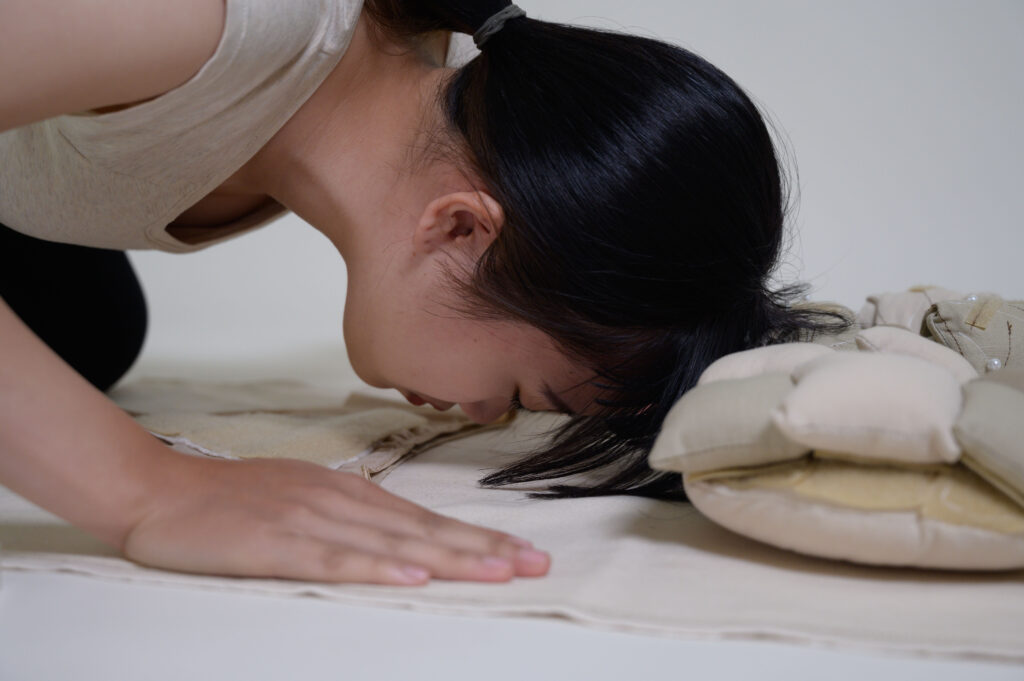Your cart is currently empty!
INTERVIEW | Chu Ling-Jung
Chu Ling-Jung, born in Taiwan in 2000, is an artist focused on feminism and consciousness. Her works often explore the unease in women’s body shaping and gender perception under a patriarchal society, and present these themes through deliberate bodily transformations. Chu Ling-Jung ‘s creative forms are diverse, including performance art, video, and found objects. Through these mediums, she explores and presents the phenomena of the body in predetermined life events.
Chu Ling-Jung attempts to reflect on her own external heterogeneity through bodily performance and physical transformation. She believes that by establishing shared life experiences with the audience, the resonance created through the presentation of art appears to enable both herself and the viewers to mutually engage in each other’s sensory worlds. In her view, this sensory interpretation of art by the viewer is akin to achieving an enlightenment-like realization. She believes that the interweaving of human thoughts and the overlapping of life experiences in artistic expression represent her vision and ideals for the world of art.
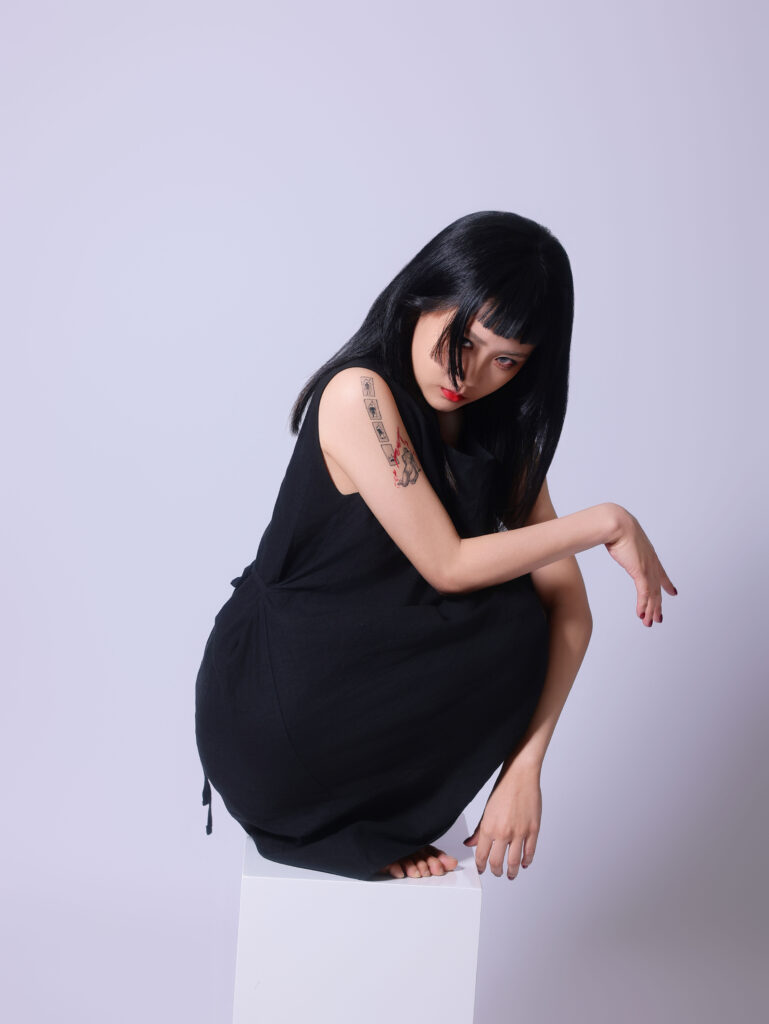
Personal Website : https://chulingjung.myportfolio.com/ | Instagram : chu_lingjung
____________________________________________________________________________________________________________
In Chu Ling-Jung’s artistic statement, she mentions wanting to apply theatrical thinking to performance art. She uses chapters from dramatic concepts to present her work, a method of ‘dramatizing’ predetermined events in her life through performance. She arranges the content of each performance art piece by dividing it into chapters, linking these together to
create a ‘dramatic’ performance work. In this process, she layers the narrative through changes in her physical appearance and adjustments in her performance form, extending the plot through the articulation of her actions. By utilizing various objects and tools to deform the body, this performance controls and resists the inherent physiological phenomena of the female body.
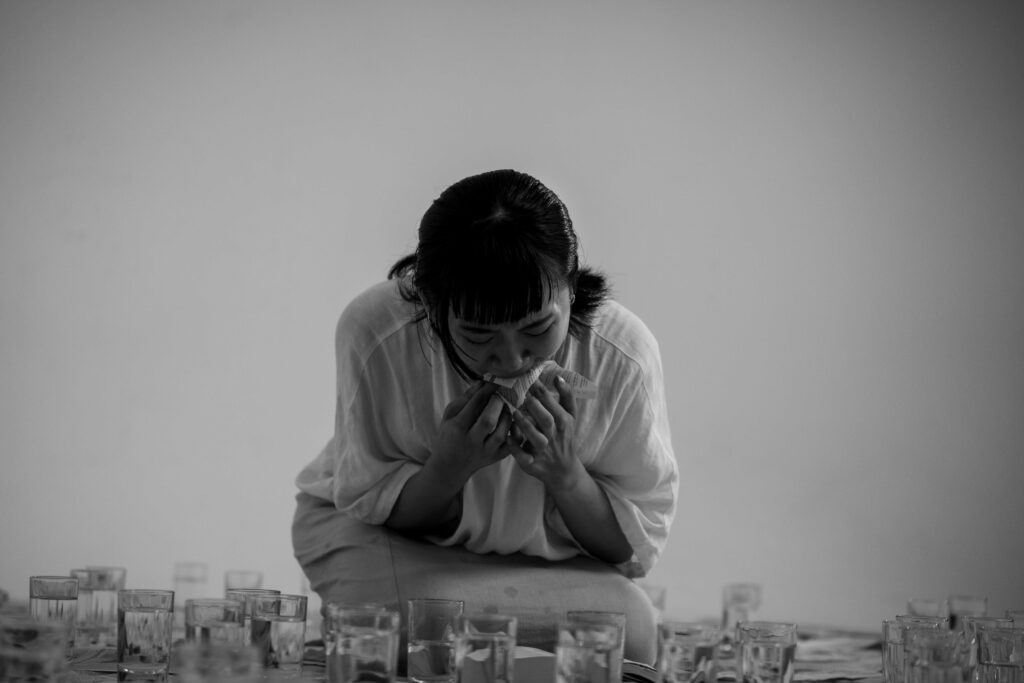
1.How does the use of performance art enable you to address the unease in women’s body shaping and gender perception under a patriarchal society in ways that other mediums might not?
I choose performance art as my primary medium of creation, aiming to express the unease women feel about body shaping and gender perception in a patriarchal society. This choice stems from my stance against gender essentialism, as I believe gender identity should be based on cultural constructs rather than merely determined by biological or essential factors. This
choice stems from the concept in performance art that creating ‘life events’ oneself can effectively counter essentialist thinking. At the same time, looking back at the historical context of feminist performance art, women using their own bodies as a medium is a crucial strategy to resist the male gaze. I choose the body as my primary medium, based on this line of thinking and historical context to initiate my creative work.
2.What considerations guide your choice of objects and tools for bodily deformation in your performances?
When exploring the relationship between objects and bodily transformations, I focus on the symbolic meanings inherent in the objects themselves, incorporating them into my creative process. For me, objects symbolize a metaphor for bodily transformation before it occurs, serving as a crucial precursor to the ‘event’.
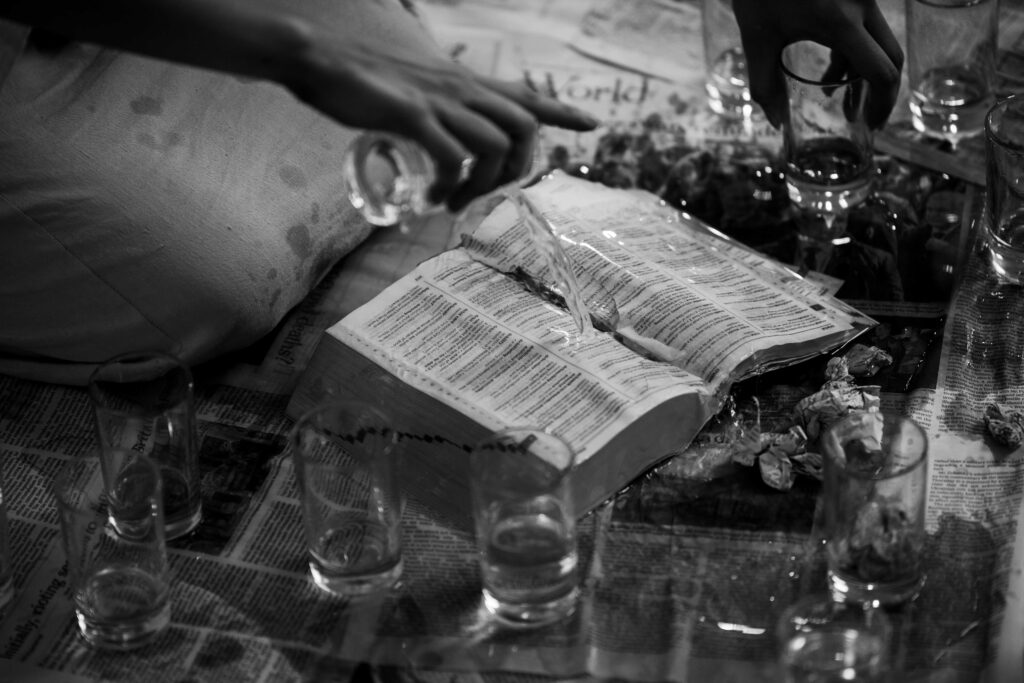
3.How do these physical transformations shape the audience’s perception of the female body and its physiological phenomena?
I hope to use bodily transformation as a narrative method, thereby guiding viewers to engage in reverse logical thinking about the ‘dramatization’ of the concept of ‘events’ in performance art. Is the female body inherently essentialized? If we ‘script’ the existence of the body by writing our own life stories, can we overturn the patriarchal society’s entrenched notions of female essence?
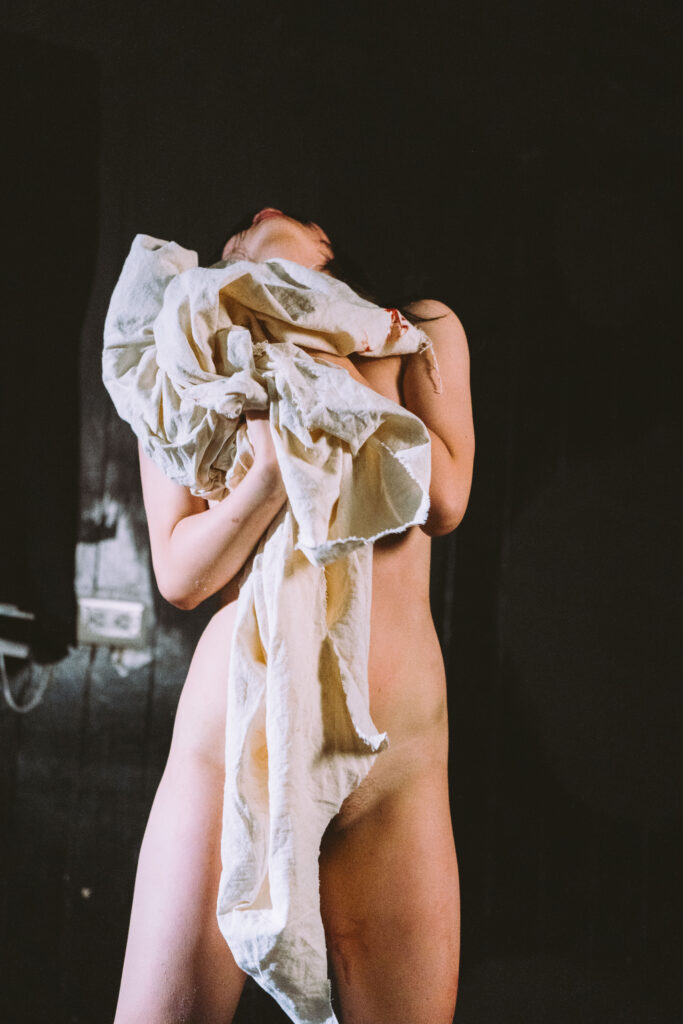
4.How do you navigate the tension between personal vulnerability and universal themes of feminism in your art?
When seeking a balance between personal experiences and feminist issues, I tend to use my own life experiences as the basis for divergent creative thinking. The key lies in how to connect personal experiences with social issues and further lead the audience to resonate. I believe the most important thing is to extend deep thinking about the essence and causes of phenomena from personal experience. This approach not only deepens personal emotional engagement in artistic creation but also promotes societal awareness and reflection on relevant issues, achieving a healthy balance between emotions and topics.
5.Are there specific symbolic meanings attached to the objects you use, or do they evolve through the performance process?
I believe that when selecting objects, they already carry the potential to become ‘symbols.’ However, when these objects are integrated into a performance, their original ‘symbolic’ meanings are reinterpreted, extending to deeper implications. Therefore, during the performance process, the symbolic meanings of these objects indeed evolve, becoming indispensable dynamic elements in performance art.

6.You describe the interweaving of thoughts and overlapping life experiences in artistic expression as your ideal. How do you perceive the impact of this approach on contemporary discussions around feminism?
I believe that when feminism is used as a theme in contemporary art, if handled improperly, it can easily alienate viewers or be perceived as merely didactic, thereby diminishing the original intent of the work to provoke thought, and may even backfire. After all, women’s issues have undergone many changes throughout history, and the key now lies in grasping the core of the problem and engaging in deep reflection. How can personal experiences serve as a starting point for raising issues, acting as a bridge for overlapping experiences, and enhancing the persuasiveness of the performance, thereby touching the audience on both emotional and rational levels?
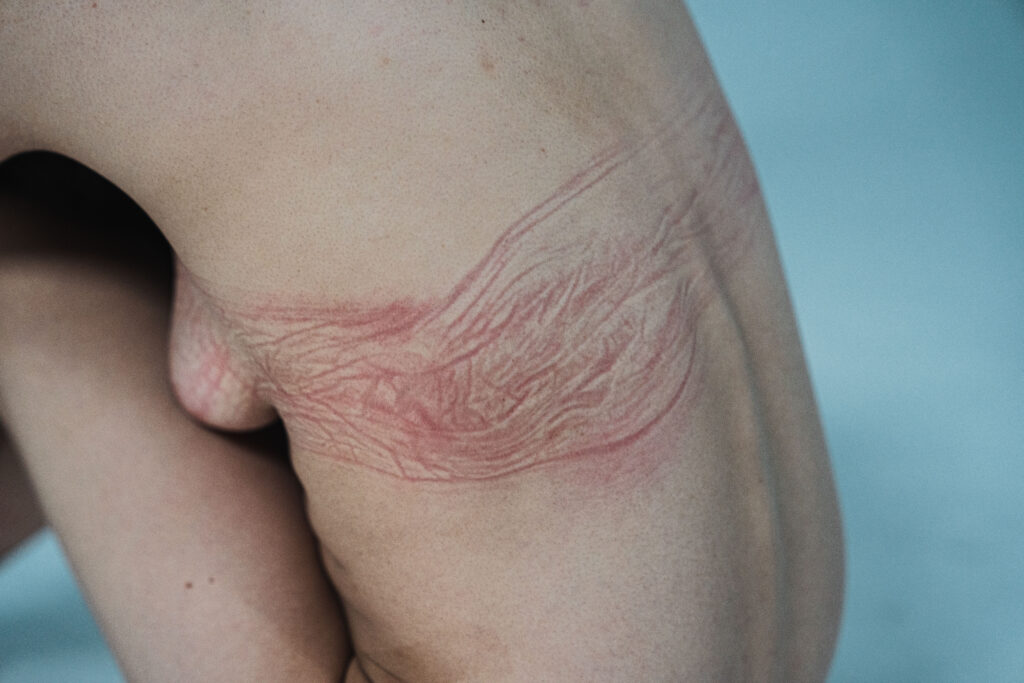
7.Are there specific cultural or societal elements that you aim to address through your performances that are unique to your experiences growing up in Taiwan?
In the environment where I grew up, women’s performance of the body and expression of desire were often regarded as symbols of impurity. Therefore, through the most direct and authentic performance, I aim to challenge and dismantle various myths surrounding the female body in social and cultural contexts, thereby sparking deeper reflections on gender and bodily autonomy.
8.In your work AV Debut, it is divided into three chapters: ‘Identity Transition,’ ‘Sexualization of Text,’ and ‘My Sarcastic “Book” Cleansing.’ How do these chapters function as a progression, and what emotional or intellectual journey do you hope to evoke in the audience?
When writing the script for this performance, I attempted to use a self-sexualizing approach as a reverse manipulation of others’ sexualized perspectives on women. In the chapters ‘Identity Transition’ and ‘My Sarcastic “Book” Cleansing,’ I pay tribute to several classic performances in the history of feminist performance art, reconstructing the representation of feminist issues within a historical context. The chapter “Sexualization of Text” serves as a reinterpretation of the chapter “Physiological Dominance” in the performance “Defiance in Nude.” In this chapter, I metaphorically depict the process of sexual intercourse and the reality of women’s limited control over reproductive rights through objects, reinterpreting the profound implications of this issue in the performance.
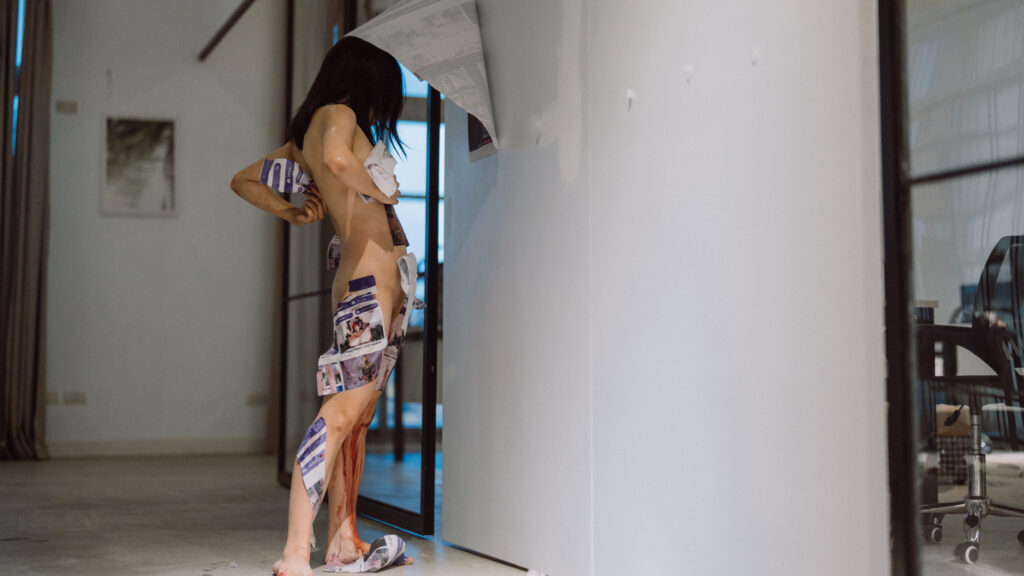
9.How does the concept of androgyny in your work challenge traditional perceptions of gender roles and reshape the understanding of identity in both private and public contexts?
When studying the issues of women in public and private domains, I reviewed numerous works on the evolution of women’s roles in these domains across different cultures and countries. Through these texts, I discovered that the phenomenon of “degendering” when women step into the public sphere often still falls within the framework of gender essentialism. Whether feminine or masculine, these two gender traits have become limitations and shackles when considering female characteristics.
10.How does Her Body critique the binary construct of gender as described in Simone de Beauvoir’s The Second Sex, and what alternatives or expansions do you propose through the work?
In this work, I use the design of fiber sculptures to depict events triggered by two contrasting forms of body modification—breast augmentation and breast ironing—and further explore the issue of female body shaping in a patriarchal society. Through the process of performing fiber sculpture in my art, I adopted three different perspectives for presentation: the first perspective originates from women oppressed by patriarchy, showcasing their bodily experiences and emotions within this structure; the second perspective approaches from a male viewpoint focused solely on female sexual characteristics, highlighting the limitations and biases of the gendered gaze; the third perspective adopts a third-person observational stance, embodying the viewer to examine the contrast between the two narratives and attempting to unravel the issue of
the male gaze. Through the interplay and presentation of these three perspectives, I aim to explore and reveal the multifaceted and contradictory shaping of women’s bodies within patriarchal culture, thereby provoking deeper reflection on gender perspectives and bodily autonomy.
